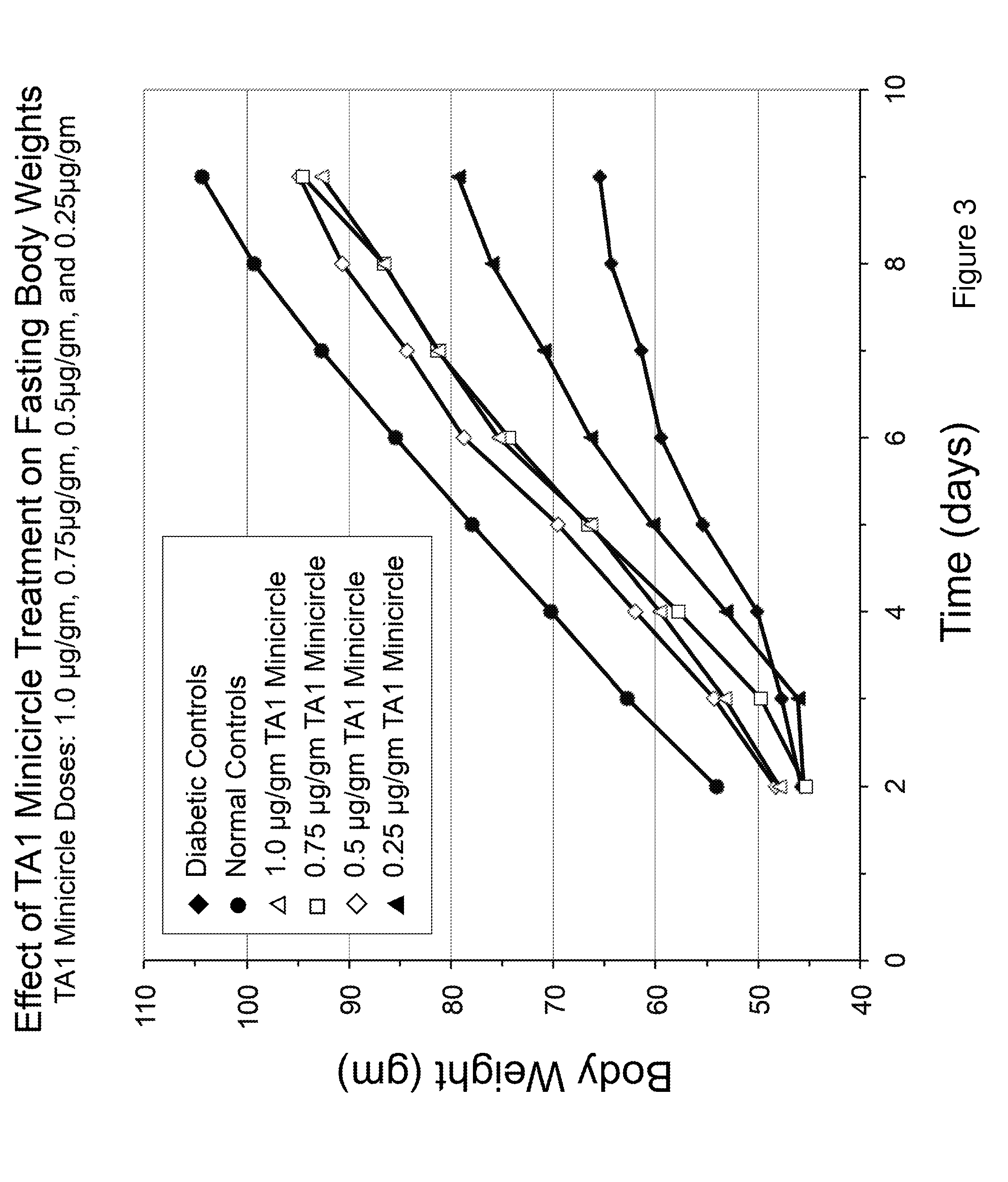Hepatocyte Based Insulin Gene Therapy For Diabetes
a technology of hepatocytes and insulin, applied in the direction of drugs, viruses, metabolic disorders, etc., can solve the problems of diabetes being fatal, blood glucose levels to drop to dangerously low levels, glucose uptake and high blood glucose levels, etc., and achieve the effect of reducing the cholesterol level of the mammal
- Summary
- Abstract
- Description
- Claims
- Application Information
AI Technical Summary
Benefits of technology
Problems solved by technology
Method used
Image
Examples
example 1
Generation of Constructs
[0085]Human insulin based gene constructs containing various elements to modulate expression were generated with the aim of producing biologically active insulin in response to changes in glucose levels.
[0086]Four insulin constructs designated TA1, TA2, TA3, and TA4 contain various elements in order shown below:
AFP-Alb-HGH-HumanAlbEnhancer3GIREsPromoterintronInsulin3′-UTRTA1YYYNYYTA2YYYYYYTA3NYYNYYTA4NYYYYYAFP-Enhancer: Alphafetoprotein enhancer was used from Mirus vector pMIR0375.3GIREs: 3 units of glucose inducible regulatory elements are connected in tandem; the sequences are based on S14. S14 is a glucose responsive transcriptional enhancer. The elements responsible for glucose-dependent transcriptional enhancement have been identified in published work: Shih H, Towle HC. Definition of the carbohydrate response element of the rat S14 gene: Context of the CACGTG motif determines the specificity of carbohydrate regulation. J Biol Chem 1994; 269: 9380.Alb-Pr...
example 2
Creation of Adenovirus Constructs
[0100]Referring to FIG. 12, insulin constructs TA1 and TA4 were created in adenovirus and equal plaque forming units injected into rat livers, as indicated. TA1 and TA4 were used under identical conditions. Both were able to fully correct fasting hyperglycemia, as shown in FIG. 12. However, the vectors did not fully correct blood glucose levels in rats fed ad libitum.
[0101]Referring to FIG. 13, TA1 in adenovirus was injected into rat livers as indicated. Note that the TA1 treated rats regained the weight initially lost due to diabetes and maintained a higher weight than the STZ diabetic rats.
[0102]Referring to FIG. 14, TA1 or TA4 in adenovirus was injected into livers of diabetic rat groups, as indicated. Note that both TA1 treated and TA4 treated rats had maintained higher body weight than STZ diabetic rats. FIG. 14 shows a subset of data points from FIG. 13, representing 0-48 days. The information on rate of weight gain in various groups of rats (s...
example 3
Evaluation of Human Insulin in Serum of Diabetic Rats
[0103]Referring to FIG. 15, a comparison of human insulin in rat serum shows that animals treated with TA1 minicircle DNA produce larger amounts of insulin compared to other plasmid vectors (pTED110, TA1 / pENTR). The plasmid pENTR contains an ampicillin resistance gene which has been replaced by a Kanamycin resistance gene in pTED110, and S / MAR has also been added to it; both have the TA1 insulin construct. The TA1 minicircle containing S / MAR produced the most insulin in vivo. The Ultrasensitive Human Insulin ELISA (Mercodia, Inc) has a detection limit of 0.15-20 mU / L, as advertised. The table in FIG. 15 shows the relative in vivo effectiveness of various vectors used for insulin gene therapy. All insulin vectors contained the TA1 expression cassette. pENTR is a commercial plasmid containing an ampicillin resistance gene. The pTED is our modified plasmid where we replaced the ampicillin resistance gene with kanamycin resistance gen...
PUM
| Property | Measurement | Unit |
|---|---|---|
| concentration | aaaaa | aaaaa |
| body weight | aaaaa | aaaaa |
| body weight | aaaaa | aaaaa |
Abstract
Description
Claims
Application Information
 Login to View More
Login to View More - R&D
- Intellectual Property
- Life Sciences
- Materials
- Tech Scout
- Unparalleled Data Quality
- Higher Quality Content
- 60% Fewer Hallucinations
Browse by: Latest US Patents, China's latest patents, Technical Efficacy Thesaurus, Application Domain, Technology Topic, Popular Technical Reports.
© 2025 PatSnap. All rights reserved.Legal|Privacy policy|Modern Slavery Act Transparency Statement|Sitemap|About US| Contact US: help@patsnap.com



